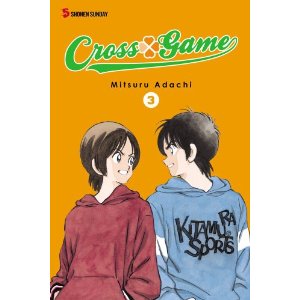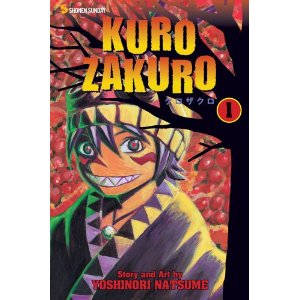I was so happy that Cross Game was selected to be featured in the May Moveable Feast. It is very rare to come across anything that is so well executed that it immediately wins me over, but that was my reaction to the first and second omnibus volumes. In broad strokes, a battle for the soul of baseball has been set up over the first few volumes, and the third volume (which contains the Japanese volumes 6 and 7) shows the ultimate confrontation between the corrupt new coach’s handpicked team of elites vs Ko’s natural talent and the enthusiasm of the second tier Portable team. I love the cover for this volume, which shoes Ko and Aoba standing shoulder to shoulder and snarling at each other. It serves as an excellent illustration for the way their relationship is simultaneously close and antagonistic.
The portable team’s game against the main team also becomes a battle for the main coaching position. The Seishu coach Daimon continues to be blind in his pursuit of success. He and the interim principal don’t realize that the scruffy old man hanging out at the baseball field is actually the chairman of the board. Daimon assumes that the portable team’s losing streak means that they’ll be easy to beat. Seishu team start Azuma has been observing his teammates leave and Daimon’s complete unconcern for the health of his players. He announces that he isn’t going to be playing in the game, slamming his hand into the wall and saying that he’s too injured to play. Azuma only wants to play baseball with the best team, and if the Seishu team can only win with him, he knows where he really be should be.
Aoba is recruited to play with Ko’s team and objects to being assigned to play center because she wants to pitch. Akaishi comments that she hasn’t faced off against Ko in a long time. Ko pitches to her, and Akaishi confirms that center is now ok with her. The match starts, and the score remains tied at 0-0 for a long time. Azuma keeps making pointed comments at Daimon, wondering if he even knows the names of the teams the portable team lost to. It turns out that they were practicing against elite teams, and Ko was deliberately allowing hits for most of the game in order to give everybody fielding practice. The game progresses and the look of dawning horror on Daimon’s face is quite enjoyable.
One thing I liked about this volume is it gave increased insights into Azuma’s personality and motivations. He’s always seemed a bit like a grim warrior of baseball, but now I can finally understand why he’s so driven. Azuma’s older brother Junpei appears and starts trying to chat up the oldest Wakaba sister, Ichiyo. On the surface Junpei seems goofy and laid back, but when he comes across his brother training Junpei picks up a baseball with a practiced grip. Azuma tells his brother that he promises that he’ll get to Koshien. Junpei just replies that Azuma should have more fun with baseball and walks away, leaving the ball on a chair. Junpei was an athletic star, but his dream was derailed when he was injured.
After the long buildup to the confrontation between the coaches and baseball teams, it was a relief to see that the rest of the volume was focused on shorter slice of life stories. It felt to me like the characters finally had a bit of breathing room. Azuma moves in with Ko’s family when the dorms are shut down. Aoba is getting hit on all the time. Memories of Wakaba continue to cascade through Aoba and Ko’s lives. This volume felt like the conclusion of the first major story arc of the series. I’m still loving the combination of action, romance, humor, and drama. It is rare to find a series that functions well on so many levels. I’m eager to see the next chapters that show Ko working to get to the ultimate baseball tournament at Koshien.



